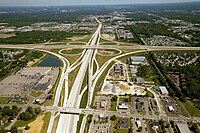
Photo from wikipedia
Cellular automata (CA) simulation models developed for traffic are either closed or open boundary type. The selection and difference of boundaries has been studied extensively for ideal and single-lane homogeneous… Click to show full abstract
Cellular automata (CA) simulation models developed for traffic are either closed or open boundary type. The selection and difference of boundaries has been studied extensively for ideal and single-lane homogeneous traffic conditions. However, the effect of these on multi-lane-heterogeneous traffic still needs attention because most of the traffic observed in many parts of the world is not single-lane homogeneous traffic. It is evident from multiple studies that open and closed boundaries affect the simulation results. Moreover, these require different inputs for simulation. This study attempts to evaluate the difference in the results of open and closed boundary simulations in heterogeneous non-lane-based traffic. The methodology discussed in this study is relatable to the field conditions. The present study includes some of the common but often ignored features in the model such as seepage of small-sized vehicles. Furthermore, this study also includes some of the previously unnoticed features while modeling the non-lane-based traffic at intersections. The modeling of open boundaries simulation can be better and easy in most of the situations compared to the closed boundaries. Closed boundary simulation results for flow-density curve show a smooth trend, whereas open boundary simulation results are scattered as observed in the field. This study further concludes that the size of the vehicle does not change the fundamental diagrams except when other characteristics such as seepage, lane change, and different maximum speeds for different modes are considered. The study used field observed influence zone of intersections to decide the dimension of intersection in the simulation model.
Journal Title: SIMULATION
Year Published: 2022
Link to full text (if available)
Share on Social Media: Sign Up to like & get
recommendations!